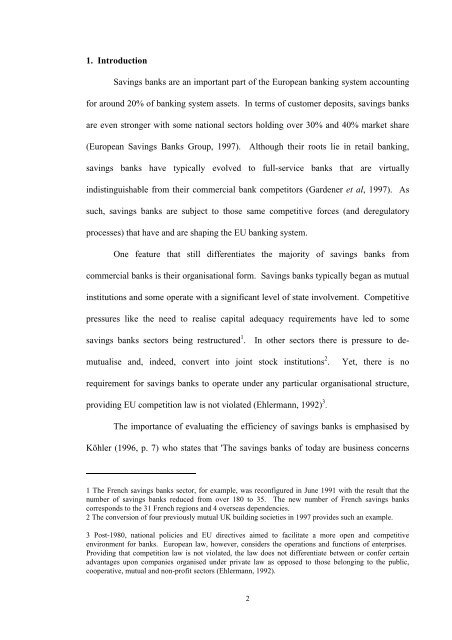Efficiency in Banking: Empirical Evidence from the Savings ... - Ivie
You also want an ePaper? Increase the reach of your titles
YUMPU automatically turns print PDFs into web optimized ePapers that Google loves.
1. Introduction<br />
Sav<strong>in</strong>gs banks are an important part of <strong>the</strong> European bank<strong>in</strong>g system account<strong>in</strong>g<br />
for around 20% of bank<strong>in</strong>g system assets. In terms of customer deposits, sav<strong>in</strong>gs banks<br />
are even stronger with some national sectors hold<strong>in</strong>g over 30% and 40% market share<br />
(European Sav<strong>in</strong>gs Banks Group, 1997). Although <strong>the</strong>ir roots lie <strong>in</strong> retail bank<strong>in</strong>g,<br />
sav<strong>in</strong>gs banks have typically evolved to full-service banks that are virtually<br />
<strong>in</strong>dist<strong>in</strong>guishable <strong>from</strong> <strong>the</strong>ir commercial bank competitors (Gardener et al, 1997). As<br />
such, sav<strong>in</strong>gs banks are subject to those same competitive forces (and deregulatory<br />
processes) that have and are shap<strong>in</strong>g <strong>the</strong> EU bank<strong>in</strong>g system.<br />
One feature that still differentiates <strong>the</strong> majority of sav<strong>in</strong>gs banks <strong>from</strong><br />
commercial banks is <strong>the</strong>ir organisational form. Sav<strong>in</strong>gs banks typically began as mutual<br />
<strong>in</strong>stitutions and some operate with a significant level of state <strong>in</strong>volvement. Competitive<br />
pressures like <strong>the</strong> need to realise capital adequacy requirements have led to some<br />
sav<strong>in</strong>gs banks sectors be<strong>in</strong>g restructured 1 . In o<strong>the</strong>r sectors <strong>the</strong>re is pressure to demutualise<br />
and, <strong>in</strong>deed, convert <strong>in</strong>to jo<strong>in</strong>t stock <strong>in</strong>stitutions 2 . Yet, <strong>the</strong>re is no<br />
requirement for sav<strong>in</strong>gs banks to operate under any particular organisational structure,<br />
provid<strong>in</strong>g EU competition law is not violated (Ehlermann, 1992) 3 .<br />
The importance of evaluat<strong>in</strong>g <strong>the</strong> efficiency of sav<strong>in</strong>gs banks is emphasised by<br />
Köhler (1996, p. 7) who states that 'The sav<strong>in</strong>gs banks of today are bus<strong>in</strong>ess concerns<br />
1 The French sav<strong>in</strong>gs banks sector, for example, was reconfigured <strong>in</strong> June 1991 with <strong>the</strong> result that <strong>the</strong><br />
number of sav<strong>in</strong>gs banks reduced <strong>from</strong> over 180 to 35. The new number of French sav<strong>in</strong>gs banks<br />
corresponds to <strong>the</strong> 31 French regions and 4 overseas dependencies.<br />
2 The conversion of four previously mutual UK build<strong>in</strong>g societies <strong>in</strong> 1997 provides such an example.<br />
3 Post-1980, national policies and EU directives aimed to facilitate a more open and competitive<br />
environment for banks. European law, however, considers <strong>the</strong> operations and functions of enterprises.<br />
Provid<strong>in</strong>g that competition law is not violated, <strong>the</strong> law does not differentiate between or confer certa<strong>in</strong><br />
advantages upon companies organised under private law as opposed to those belong<strong>in</strong>g to <strong>the</strong> public,<br />
cooperative, mutual and non-profit sectors (Ehlermann, 1992).<br />
2
















